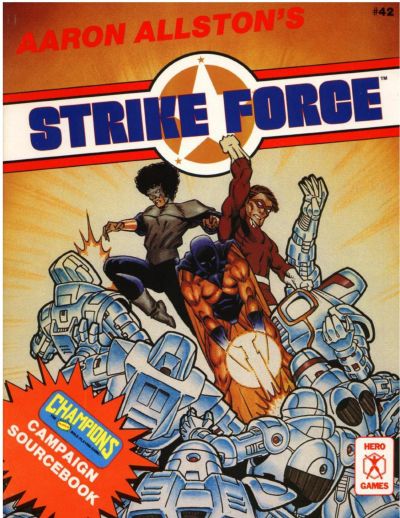Trying to Save the World
Strike Force
By Aaron Allston

14 May, 2020
Aaron Allston’s 1988 Strike Force was a campaign source book for the third edition of Hero Games’ superhero roleplaying game Champions. The book is based on the author’s long experience (close to a decade) of running games based on various editions of Champions.
The sourcebook was an unintended consequence:
In the summer of 1981, I was loaned one of the first copies of Champions in order to write a review of the game for Space Gamer magazine. I playtested the game for review — and that “playtest” has been going on ever since.
In other words, when Allston sat down to compose Strike Force, he had amassed as much experience running an ongoing SHRPG campaign as it was possible to have in 1988. Of course, there is a huge gulf between “running a successful campaign” and “turning it into material other gamemasters might find useful.” Thirty-two years later we can ask: how well did Allston do?
But before we proceed, some production info: the cover was by Denis Loubet, interior art by Glen Johnson & Denis Loubet. The book itself was a perfect-bound paperback, which was a great improvement on the … note to self: find nicer work for amateurish … production methods acceptable in the early years of the gaming industry.
Rather than go through this chapter by chapter — cue rejoicing from my long-suffering editor — I will take a bird’s‑eye view. Strike Force falls into two main sections: general advice on long-term campaigning and observations on the campaign Allston ran from 1981 to 1988.
The general advice section covers issues like integrating new players into existing campaigns, keeping old players happy, and providing a fun time for all concerned. Included in this section are some thumbnail descriptions of the most common types of players, with notes on what they typically want from gaming. As well, Allston provides a handy guide to sabotaging campaigns, advice on how to vex and annoy players so they will surely storm away from the table. When inverted, this is a guide to NOT doing so. As we used to say while playing with explosives on the farm, you cannot avoid hazards whose existence you do not suspect.
The campaign source material itself comprises the majority of the book, 81 of its 96 pages. It begins with Allston’s house rules for his personal campaign. Although these are not presented as official rule for third edition Champions, I believe most of them were incorporated into the fourth, most playable, edition of the game.
Allston gives us a quick history of the campaign, which drew on the main SH comic books for inspiration. He tells us about his two superhero teams, Strike Force (seventeen members) and the Shadow Warriors (seven members), as well as a number of independent heroes, and adds notes about the other groups and agencies with whom the heroes might work. Or come into conflict with. In addition, he covers the six antagonist groups, (whose many members are described in varying degrees of detail [1]), provides an expanded history of game settings, and includes some headquarters floor plans. And there is an adventure.
What I found most interesting were Allston’s notes on the long campaign. He and his players were making it up as they went along:
Actually, in the first adventure, the players just sat down with their characters, and I had to figure out a reason why they’d all be together. I bounced the above rationale off ShadowWalker’s player, and he was agreeable; So, in Panel One of the adventure, the heroes are all together, overlooking the rendezvous site. By game-master standards it was a crude technique … but we learn as we play.
Keeping the campaign going meant learning how to keep players with different likes and goals satisfied, and it’s not as if Allston had a sourcebook like Strike Force to draw on.
Superhero RPG art can be rather cringeworthy. There’s a lot of male gaze art drawn by people who apparently didn’t make notes while male gazing, also way too much ‘could not afford actual artists, got the writer’s cousin instead.’ But while there is cheesecake in this volume, a surprising number of the heroines own and wear trousers. The art could be much much worse. Perhaps the worst I can say of the art is that people seem to have loved off the shoulder sweaters in 1988.
As for me, looking at Loubet art brought back a lot of fond memories.
I recalled the campaign advice as revelatory! Impressive! On re-reading the book, I was surprised to find that the advice section was a mere thirteen pages long. On the other hand, it seems to have aged well … except for the section on Blue Booking (keeping paper notebooks for each character). Nowadays, we’d do that sort of player-GM bookkeeping online. Ah, but in 1988 most people didn’t have access to email and the web was still a year off. Gamers were forced to use pen and paper, like Stone Age hunter-gatherers.
When re-reading older RPG material one can run the risk of encounter with the suck fairy; no fairies were met in this re-reading. Allston’s advice is still useful today. How would more recent source books like this stand up? I imagine we’ll find out next week.
Strike Force is available here.
- It was assumed (or at least tacitly encouraged) that gamers using Strike Force would also own other Hero Games products, such as the Enemies books.
